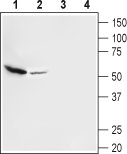Overview
- Peptide (C)ELNHEAFVSPRKK, corresponding to amino acid residues 533-545 of rat VGLUT3 (Accession Q7TSF2). Cytoplasmic, C-terminus.
- Mouse and rat brain membranes (1:500-1:1500).
 Western blot analysis of mouse (lanes 1 and 3) and rat (lanes 2 and 4) brain membranes:1,2. Anti-VGLUT3 Antibody (#AGC-037), (1:500).
Western blot analysis of mouse (lanes 1 and 3) and rat (lanes 2 and 4) brain membranes:1,2. Anti-VGLUT3 Antibody (#AGC-037), (1:500).
3,4. Anti-VGLUT3 Antibody, preincubated with VGLUT3 Blocking Peptide (#BLP-GC037).
- Rat and mouse brain sections (1:400).
Central nervous system neurons have traditionally been thought to express exclusively membrane transporters and/or vesicular transporters for their transmitter. Three vesicular glutamate transporters (VGLUTs) have recently been cloned: BNPI/VGLUT1 (a brain-specific sodium dependent inorganic phosphate (Pi) transporter), and its homologs DNPI/VGLUT2 (differentiation-associated sodium-dependent Pi transporter) and VGLUT31. These transporters mediate glutamate uptake inside presynaptic vesicles and are anatomical and functional markers of glutamatergic excitatory transmission2.
VGLUT 1-3 are very similar in structure and function, but are used by different neuronal populations. VGLUT3 is a glycosylated transmembrane protein with ten putative transmembrane domains (TMD I–X) and both amino- and carboxyl-termini located in the cytosol3.
VGLUT3 is localized in a limited number of glutamatergic neurons in multiple brain regions: neocortex, hippocampus, olfactory bulb, hypothalamus, substania nigra and raphe nuclei. Additionally, VGLUT3 is expressed in a population of symmetrical synapses. It is detected in hippocampal and cortical GABAergic neurons, cholinergic neurons in the striatum and serotonergic neurons in the raphe nuclei4.
Mice lacking VGLUT3 are congenitally deaf due to loss of glutamate release at the inner hair cell afferent synapse5. In addition loss of VGLUT3 specifically impairs mechanical pain sensation6.
